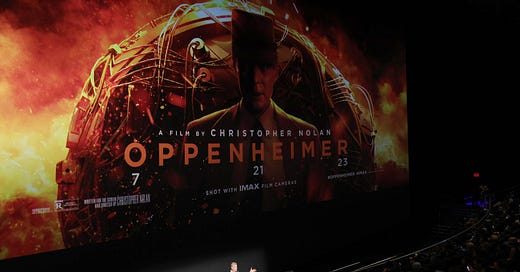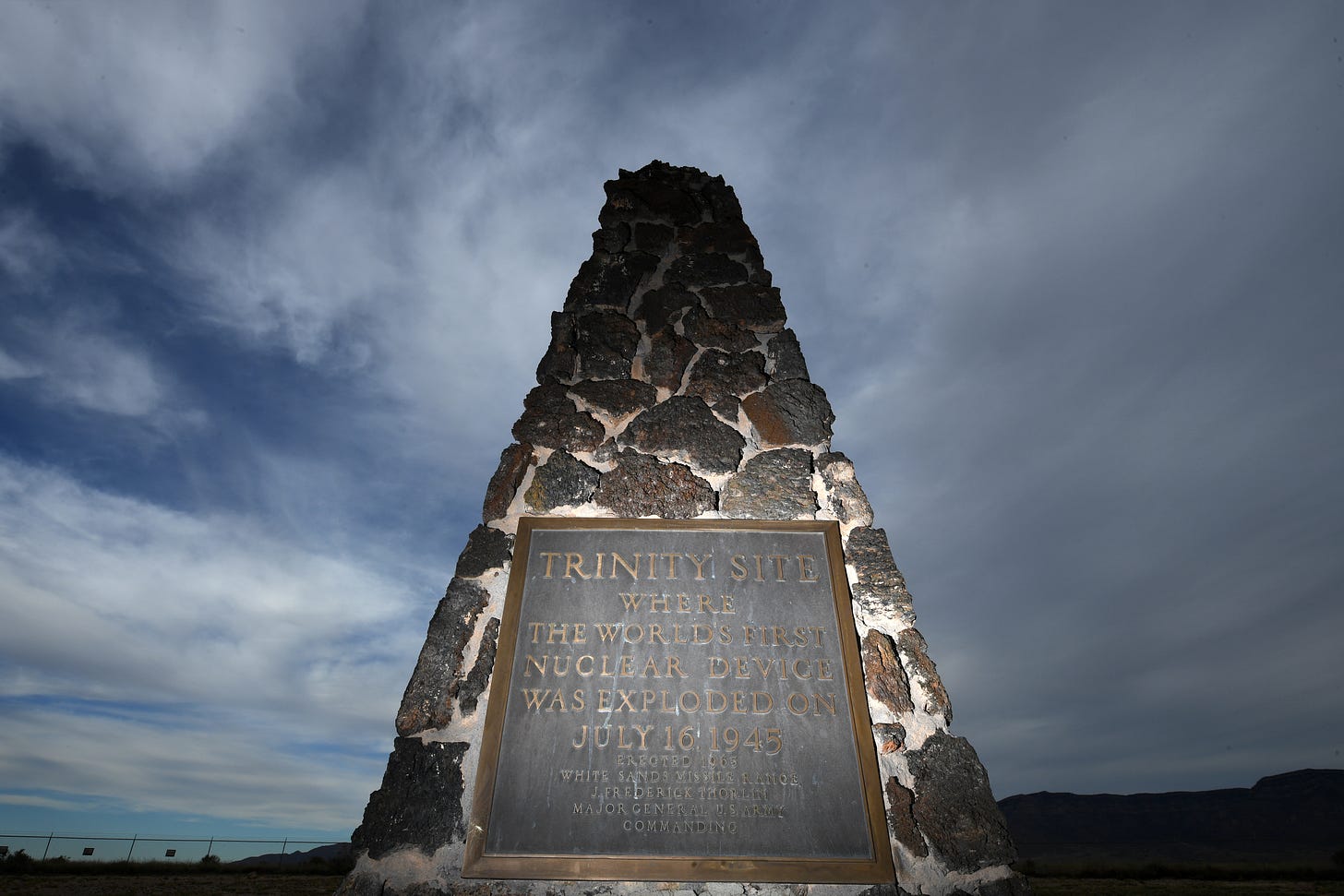

Director Christopher Nolan sure loves to play around with time and narrative structure in his films. He’s a cinematic watchmaker obsessed with constructing intricate gadgets containing exquisite moving pieces that serve mainly to showcase his impressive skill as a filmmaker. To put it bluntly, Nolan’s movies—from Memento and Inception to Interstellar and Dunkirk—usually come across as clever, aesthetically pleasing puzzles rather than works of art that convey certain moods or have something profound to say about a particular subject.
Nolan’s penchant for non-linear, nested storytelling finally pays off in a big way with this summer’s much-anticipated Oppenheimer. Here, Nolan’s methods serve his narrative rather than the other way around, illustrating the fragility of memory and allowing him to examine physicist J. Robert Oppenheimer’s life in an episodic fashion. The end result is a film that’s serious and intense but never heavy or self-important; it has a sense of gravity appropriate to the subject matter it dwells upon.
That’s as much a reflection of the fundamental moral ambiguity and ambivalence that surrounds the film’s treatment of nuclear weapons. Nolan doesn’t give viewers easy or pat answers with this film; he doesn’t spoon-feed us “correct” moral and political positions about the development and use of nuclear weapons during World War II. At bottom, Oppenheimer isn’t a film that seeks to condemn or praise but show how individuals and institutions can accomplish incredible feats—only to inevitably lay themselves low later on through hubris or paranoia. It’s tragedy distilled down to its essence: no one—not Oppenheimer, not his personal and professional rivals, not humanity—comes out ahead at the end of an inevitable, unalterable chain of events.
First and foremost, however, Oppenheimer is a well-crafted piece of cinema. Both Cillian Murphy and Robert Downey, Jr. are exceptionally well cast as Oppenheimer and his eventual nemesis, Atomic Energy Commission member Lewis Strauss. Murphy in particular inhabits the role of Oppenheimer in just about every way possible; he’s introspective and brilliant, beloved by many and yet too often arrogant and alienating to others. He’s able to help orchestrate one of the most impressive achievements of science and engineering in human history (alongside Matt Damon’s Gen. Leslie Groves) but nowhere near as expert at managing his own personal and professional relationships. Oppenheimer comes across as a man both naïve and hard-headed about his work and his politics, carrying on an extramarital romantic liaison with a Florence Pugh’s communist activist as the Manhattan Project ramps up while warning the U.S. military of a potential security threat.
Likewise, Robert Downey, Jr. makes the film’s antagonist, Strauss, a sympathetic character. A self-proclaimed self-made man, all Strauss wants is a little respect from the likes of Oppenheimer and other scientists. When Strauss doesn’t receive it—indeed, Oppenheimer publicly humiliates him over a policy disagreement—his desire for respect curdles into deep resentment over all sorts of perceived slights. But this strong vindictive streak comes to haunt Strauss, as his role in bringing down Oppenheimer resurfaces during hearings for his own nomination to head the Department of Commerce and results in Congress denying him the position.
Nolan himself is at the top of his own directorial game, allowing his obsession with non-linear and nested storytelling serve the film rather than the other way around as has too often been the case in his work. The movie smoothly shifts back and forth between Oppenheimer’s 1954 security hearing, Strauss’ 1958 confirmation hearing, the pair’s policy clashes over the export of nuclear material and the development of the hydrogen bomb in 1949, and a more-or-less linear account of Oppenheimer’s career as a physicist up to the end of the Manhattan Project in 1945. But it’s Nolan’s tense depiction of the Trinity test of July 1945 that stands out as a truly great piece of filmmaking, a sequence that manages to steadily ratchet up the suspense despite everyone in the theater knowing the outcome. Composer Ludwig Göransson’s score works wonders here, fueling a sense of nervous anticipation as the Trinity countdown marches inexorably forward.
Though Oppenheimer focuses in large part on its title character’s dramatic fall from grace, the film doesn’t exactly present Oppenheimer himself as a martyr. The movie makes clear that Oppenheimer was unfairly targeted and hounded out of public life by his rivals, above all Strauss. But it’s equally clear that Oppenheimer’s own personal aloofness and hubris as the great man of science contributed to his own undoing in real and significant ways. He could not resist publicly demolishing a policy supported by Strauss, for instance, in the most theatrical and demeaning way possible. It’s not that Oppenheimer didn’t have enemies, or that the political atmosphere of the mid-1950s wasn’t febrile and poisonous—but Oppenheimer himself gave these enemies all the ammunition they needed to lay him low.
The same goes for Oppenheimer’s nemesis Lewis Strauss, himself brought down by his own self-absorption and insecurity. As the film presents it, the seed of his personal and professional vendetta against Oppenheimer is planted when Strauss witnesses a conversation between Oppenheimer and Albert Einstein and imagines the twentieth century’s two most famous physicists have been maligning him personally. At the movie’s end, however, it’s revealed that Einstein and Oppenheimer were in fact contemplating the possibility that humanity might use nuclear weapons to destroy itself—not detailing the shortcomings of one Lewis Strauss. His pursuit of this feud cost Strauss his desired cabinet post when lawmakers question his own role in Oppenheimer’s dismissal.
That may be the ultimate point of Oppenheimer: for all our very real scientific and technological progress, human nature hasn’t changed all that much. It’s something both Strauss and Oppenheimer embody each in their own way as they each grapple with the moral and practical problems created by the mere existence of nuclear weapons. Both men are ultimately undone by their personal flaws and serious lapses in judgment, but Oppenheimer at least possesses the self-awareness to understand how he himself may have contributed to his own troubles.
But that also makes the political and policy disagreements touched on in the film somewhat beside the point. Oppenheimer doesn’t delve too deeply into the moral and military arguments for and against the use of the bomb against Japan or the technical and political debates about the development of the hydrogen bomb; the film only really concerns itself with these questions insofar as they constitute points of friction between Oppenheimer and other characters. When Oppenheimer visits the White House and meets with President Truman to express qualms over his role in creating nuclear weapons, for instance, Truman brusquely reminds Oppenheimer that he—not Oppenheimer or anyone else—bears ultimate moral responsibility for the decision to use the bomb. It’s part and parcel of the ambiguity and ambivalence toward nuclear weapons at the heart of the film itself: these weapons were bound to be made, if not used. They still exist and, absent some sudden and profound revolution in all known forms of human behavior, they’re not going away anytime soon—if ever.
For all the historical close calls and newfound worries about nuclear weapons we now face today, it’s hard to be as down about humanity’s ultimate prospects as Nolan himself seems to be in the film’s final frames. Take it from Oppenheimer himself: in a television interview late in life, he observed that while the new institutions he believed were needed to prevent nuclear war had not emerged (and likely never will), the “new patterns of behavior” he viewed as necessary were indeed visible in moves like the then-recently established hotline between the White House and the Kremlin. He characterized these moves “faulty, frail, very vulnerable,” but they nonetheless offered a modicum of hope amid the prevalent nuclear pessimism of the mid-1960s.
What’s become clear in recent years, however, is that the United States and other nuclear powers need to establish new patterns of behavior that better reflect the world as it is today. America and its allies, for instance, cannot cower in fear every time Moscow vaguely gestures toward the possibility of nuclear war if it does not get its way in Ukraine or on some other geopolitical question; that pattern of behavior only encourages nuclear recklessness. Likewise, the Chinese government’s refusal to even pick up the phone during mild crises like last February’s spy balloon incident does not augur well given heightened tensions with the United States over Taiwan and Beijing’s own expanding nuclear arsenal. That’s not even getting to the prospect that Iran might join the nuclear club, or the fact that North Korea continues to make progress on its own intercontinental ballistic missile program.
Still, Oppenheimer reminds us that we ought to take nuclear weapons as seriously today as we did in the years that followed their invention and first—and hopefully only—use. In the three decades after the end of the Cold War, the world didn’t need to contemplate nuclear war all that much; activists and sober statesmen alike were able to pursue dreams of nuclear abolition. That era, unfortunately, has come to a close.
Like it or not, we’ve got to find a way to live with nuclear weapons—if only to avoid the catastrophic consequences that will ensue if we don’t. As Oppenheimer suggests, there aren’t any simple or easy—or even good—answers to this question. But that doesn’t absolve us of our responsibility to wrestle with it as best we can and in good faith.
If humanity does eventually destroy itself with nuclear weapons, it shouldn’t be from lack of trying to stop it.










